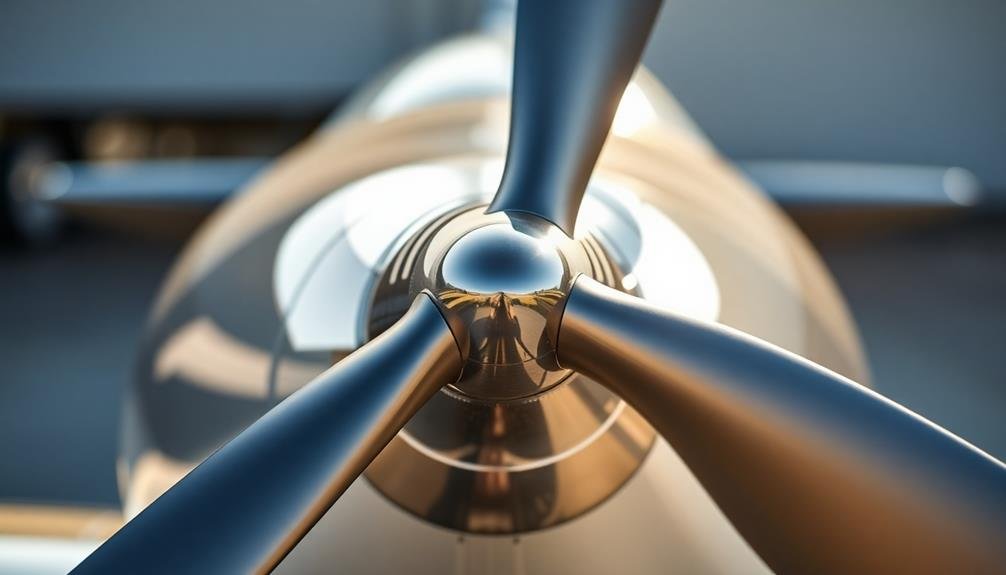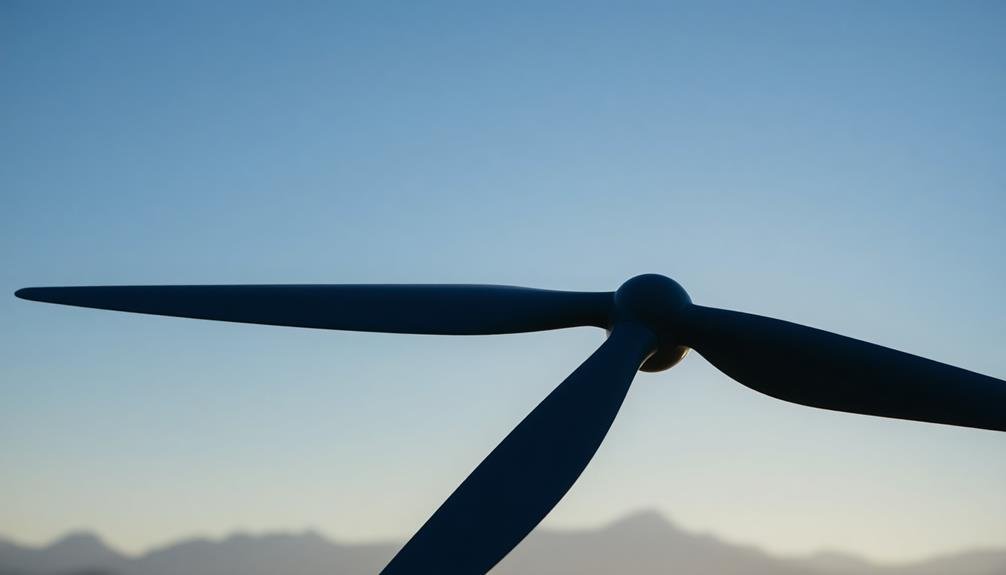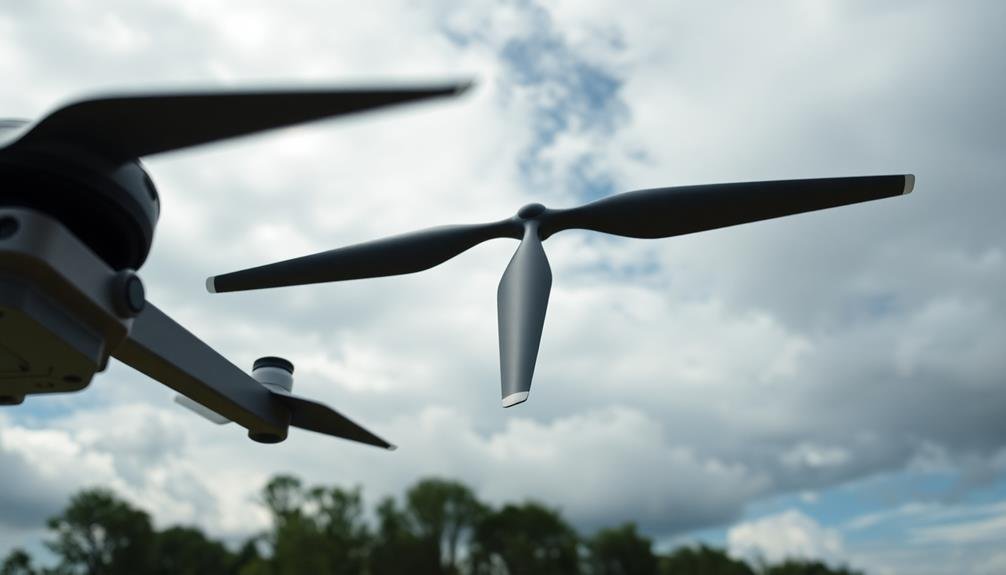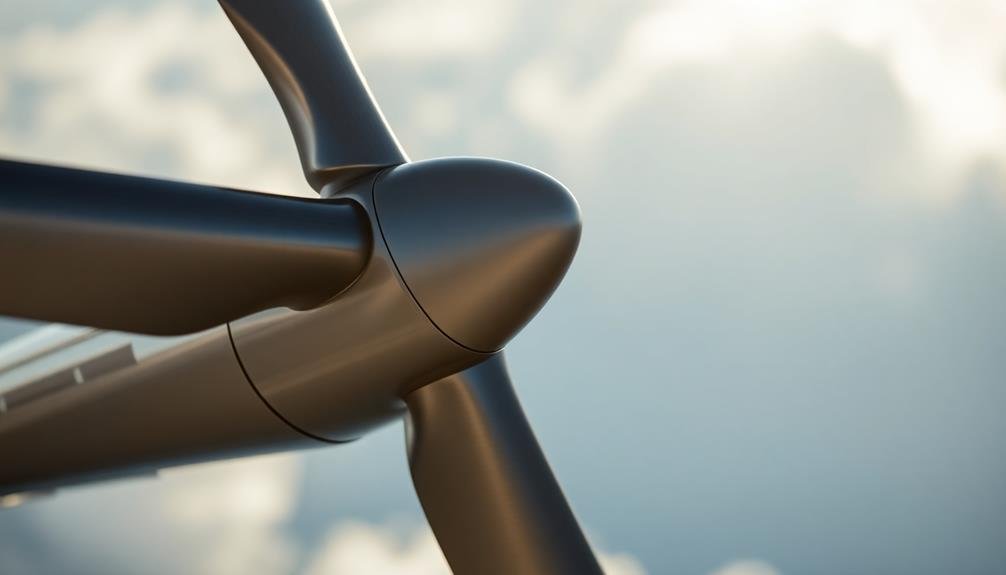When seeking rock-solid flight stability, you'll want to take into account these top propeller types: Carbon Fiber T-Style, Low-Noise Folding, Self-Tightening, Quick-Release, Reinforced Plastic, Balanced Tri-Blade, High-Altitude Performance, Wind-Resistant, Precision-Engineered Racing, and Durable All-Weather propellers. Each type offers unique features to enhance your aircraft's performance, from reducing vibrations to maximizing efficiency in various conditions. You'll find options that prioritize durability, noise reduction, or specialized performance for racing or high-altitude flights. Remember to match the propeller to your aircraft's specifications and intended use. Exploring these options further will help you make the best choice for your specific needs.
Key Takeaways
- Carbon Fiber T-Style Propellers offer exceptional stability through lightweight construction and unique design that maximizes efficiency.
- Balanced Tri-Blade Propellers provide enhanced lift, better acceleration, and improved maneuverability compared to two-blade designs.
- Wind-Resistant Propellers maintain consistent performance in gusty conditions with high twist rates and smaller diameters.
- Self-Tightening Propellers ensure consistent performance and stability while minimizing the risk of detachment during flight.
- High-Altitude Performance Propellers are engineered to maximize thrust and efficiency in low-density air at higher altitudes.
Carbon Fiber T-Style Propellers

Carbon fiber T-style propellers soar above the competition when it comes to flight stability. These lightweight yet durable props offer exceptional balance and rigidity, reducing vibrations and enhancing overall flight performance.
You'll notice a significant improvement in your aircraft's handling, especially during hovering and precision maneuvers.
The T-style design features a unique shape that maximizes efficiency while minimizing drag. This configuration allows for smoother air displacement, resulting in quieter operation and increased thrust.
You'll appreciate the reduced noise levels, particularly if you're flying in noise-sensitive areas.
Carbon fiber's strength-to-weight ratio is unmatched, making these propellers ideal for both recreational and professional use. They're resistant to bending and warping, ensuring consistent performance even in challenging weather conditions.
You'll find that they maintain their shape and balance over time, reducing the need for frequent replacements.
When selecting carbon fiber T-style propellers, consider your aircraft's specifications and intended use. Different sizes and pitches are available to optimize performance for various applications.
You'll want to match the propeller to your motor's power output and your flight goals for the best results.
Low-Noise Folding Propellers

For pilots seeking a quieter flight experience, low-noise folding propellers offer an excellent solution. These propellers are designed to minimize noise pollution while maintaining flight stability. You'll find that they're particularly useful for urban flying or in noise-sensitive areas.
Low-noise folding propellers typically feature specially engineered blade shapes and tip designs that reduce air turbulence. They're often made from lightweight materials like carbon fiber or reinforced plastics, which help dampen vibrations. The folding mechanism allows for compact storage when not in use, making them ideal for portable or collapsible aircraft.
When selecting low-noise folding propellers, consider factors such as your aircraft's power requirements, weight limitations, and intended use. You'll want to guarantee the propellers are compatible with your motor and can provide sufficient thrust. Many manufacturers offer performance data to help you make an informed choice.
While these propellers excel in noise reduction, they may have slightly lower efficiency compared to fixed propellers. However, the trade-off is often worth it for quieter operations.
You'll also need to regularly inspect the folding mechanism to guarantee it's functioning properly and doesn't compromise flight safety.
Self-Tightening Propellers

Self-tightening propellers offer you a significant advantage in flight stability and safety.
You'll find popular models like the T-Motor and Master Airscrew series that employ this innovative design.
When installing and maintaining these propellers, you'll need to follow specific guidelines to guarantee peak performance and longevity.
Advantages of Self-Tightening Design
When it comes to flight stability, self-tightening propellers offer significant advantages. You'll find that these propellers help maintain consistent performance throughout your flight. As they spin, they naturally tighten themselves, reducing the risk of loosening during operation. This self-tightening mechanism guarantees that your propellers stay securely attached, even in turbulent conditions.
You'll appreciate the enhanced safety that comes with self-tightening propellers. They minimize the chances of a propeller detaching mid-flight, which could lead to catastrophic failure. Additionally, you'll notice improved efficiency as these propellers maintain their prime position, reducing vibration and power loss.
Self-tightening propellers also save you time and effort on maintenance. You won't need to constantly check and retighten them before each flight. This feature is particularly beneficial for commercial operators and frequent flyers who value streamlined pre-flight checks.
Moreover, you'll experience more consistent flight characteristics. As the propellers remain securely fastened, they maintain their balance and aerodynamic properties throughout the flight. This stability translates to smoother operation, better control, and increased overall flight performance.
Popular Self-Tightening Propeller Models
Several popular self-tightening propeller models have gained prominence in the aviation industry. These propellers offer improved flight stability and reduced maintenance, making them a favorite among pilots and aircraft owners.
You'll find that the DJI Master Airscrew series is widely used in drones and smaller aircraft, offering excellent performance and durability. For larger aircraft, the Hartzell Scimitar series has become a go-to choice, known for its efficiency and noise reduction capabilities.
If you're looking for versatility, the Sensenich Ground Adjustable series is worth considering. It allows for easy pitch adjustments on the ground, optimizing performance for various flight conditions.
The MT-Propeller Composite series is another top contender, offering lightweight construction and exceptional strength.
When choosing a self-tightening propeller, consider these key factors:
- Aircraft compatibility
- Performance requirements
- Weight considerations
- Budget constraints
Installation and Maintenance Tips
Proper installation and regular maintenance are essential for maximizing the performance and longevity of self-tightening propellers.
When installing, confirm you're using the correct size and pitch for your aircraft. Always follow the manufacturer's guidelines for torque specifications and use a calibrated torque wrench to tighten the propeller nut.
Before each flight, visually inspect your propellers for any signs of damage, such as nicks, cracks, or delamination. Check that the blades are securely fastened and haven't become loose during previous flights. If you notice any issues, address them immediately before flying.
Clean your propellers regularly with a soft cloth and mild soap solution to remove dirt and debris. Avoid using harsh chemicals or abrasive materials that could damage the surface.
Apply a thin coat of propeller wax every few months to protect against UV rays and moisture.
Keep track of your propeller's total flight hours and adhere to the manufacturer's recommended replacement schedule. Even if there's no visible damage, propellers can develop internal stress over time.
Quick-Release Propellers

In light of the need for swift propeller changes, quick-release propellers have become a game-changer for pilots and drone operators. These innovative propellers allow you to swap them out in seconds, saving valuable time during maintenance or when adapting to different flight conditions.
You'll appreciate the convenience and efficiency they bring to your operations, especially in time-sensitive situations.
Quick-release propellers typically feature a simple locking mechanism that secures the prop to the motor shaft. To remove the propeller, you'll usually need to press a button or twist a locking collar, then pull the prop off. Installation is just as easy, with most systems allowing you to simply push the prop onto the shaft until it clicks into place.
When considering quick-release propellers, keep these factors in mind:
- Compatibility with your aircraft or drone's motor system
- Material quality and durability
- Balance and aerodynamic properties
- Weight impact on overall flight performance
While quick-release propellers offer numerous advantages, it's essential to verify they're properly seated and locked before each flight. Regular inspections of the locking mechanism will help maintain safety and reliability.
Reinforced Plastic Propellers

Reinforced plastic propellers stand out as a popular choice for pilots and drone enthusiasts due to their excellent balance of strength and weight. These propellers are typically made from high-quality, durable plastics like nylon or polycarbonate, reinforced with materials such as carbon fiber or glass fiber.
You'll find that reinforced plastic propellers offer several advantages for flight stability. They're lightweight, which reduces the overall mass of your aircraft and improves maneuverability. Despite their low weight, they're also incredibly strong and resistant to impacts, making them less likely to break during minor collisions or rough landings.
The reinforced construction helps maintain the propeller's shape during high-speed rotation, ensuring consistent performance and reducing vibration. This stability contributes greatly to smoother flights and more precise control. Additionally, these propellers are often designed with enhanced airfoil shapes, improving efficiency and thrust.
When choosing reinforced plastic propellers, consider factors like your aircraft's size, motor specifications, and intended use. You'll want to select propellers that match your setup for ideal performance.
Remember to inspect your propellers regularly for signs of wear or damage, as even reinforced plastic can degrade over time.
Balanced Tri-Blade Propellers

Balanced tri-blade propellers offer you significant advantages in flight stability.
You'll notice an improved thrust-to-weight ratio, allowing for more efficient power utilization and increased payload capacity.
These propellers also enhance your aircraft's maneuverability performance, giving you better control and responsiveness during flight operations.
Improved Thrust-To-Weight Ratio
Tri-blade propellers have revolutionized the thrust-to-weight ratio in modern aircraft. They offer significant advantages over traditional two-blade designs, providing improved performance without substantially increasing weight.
You'll notice enhanced lift, better acceleration, and more efficient power consumption when using tri-blade propellers.
The improved thrust-to-weight ratio translates to better overall flight stability. You'll experience:
- Quicker response to control inputs
- Smoother shifts between flight modes
- Reduced propeller flex during high-stress maneuvers
- More consistent performance in varying wind conditions
When selecting tri-blade propellers for your aircraft, consider the specific material composition.
Carbon fiber options offer the best strength-to-weight ratio, further enhancing the thrust-to-weight benefits.
You'll also want to pay attention to the propeller's pitch and diameter, as these factors directly impact thrust generation.
Enhanced Maneuverability Performance
Agility takes center stage when discussing balanced tri-blade propellers and their impact on maneuverability. These propellers offer a perfect blend of efficiency and responsiveness, allowing your drone to execute precise movements with ease.
You'll notice a significant improvement in your aircraft's ability to change direction quickly and maintain stability during complex flight patterns.
Balanced tri-blade propellers distribute weight evenly across the blades, reducing vibrations and enhancing overall control. This design allows for smoother shifts between hovering and forward flight, giving you more confidence when steering through tight spaces or performing aerial acrobatics.
You'll experience less prop wash, which means cleaner video footage and improved stability in windy conditions.
The increased surface area of tri-blade propellers provides better grip on the air, resulting in faster acceleration and deceleration. This translates to more responsive throttle control and the ability to make split-second adjustments mid-flight.
Whether you're racing through obstacle courses or capturing cinematic shots, these propellers will give you the edge you need to push your piloting skills to the next level.
High-Altitude Performance Propellers

Altitude poses unique challenges for propeller performance. As you climb higher, the air becomes thinner, reducing the propeller's efficiency. To maintain stability and performance at high altitudes, you'll need specialized propellers designed to cope with these conditions.
High-altitude performance propellers are engineered to maximize thrust and efficiency in low-density air. They typically feature:
- Larger diameters to move more air
- Higher pitch angles to maintain thrust
- Lighter materials to reduce weight
- Specialized airfoil designs for improved efficiency
You'll find that these propellers often have a wider chord and more blade area to compensate for the reduced air density. They're designed to operate at higher RPMs without losing efficiency, ensuring your aircraft maintains stable flight even in the thinner air of high altitudes.
When choosing high-altitude propellers, consider your aircraft's specific requirements and performance goals. Look for propellers that offer a balance between climb rate, cruise speed, and overall efficiency at your intended operating altitude.
Wind-Resistant Propellers

Gusts and turbulence can wreak havoc on flight stability, making wind-resistant propellers an essential component for pilots steering through challenging weather conditions. These specialized propellers are designed to maintain consistent performance and reduce vibrations in windy environments.
When selecting wind-resistant propellers, you'll want to look for blades with a high twist rate and a smaller diameter. This combination helps to minimize the impact of crosswinds and maintains thrust efficiency. Carbon fiber composite materials are often used in these propellers due to their strength and flexibility, allowing them to absorb sudden wind changes without compromising structural integrity.
You should also consider propellers with variable pitch technology. This feature allows the blades to adjust their angle in real-time, compensating for wind variations and maintaining ideal thrust. Some advanced models even incorporate smart sensors that detect wind patterns and automatically adjust the pitch accordingly.
For maximum wind resistance, opt for propellers with aerodynamic blade tips. These reduce vortex formation and minimize drag, enhancing overall stability in gusty conditions.
Precision-Engineered Racing Propellers

Racing enthusiasts and competitive pilots know that every fraction of a second counts. That's why precision-engineered racing propellers are essential for achieving peak performance and maintaining flight stability.
These propellers are crafted with advanced materials and cutting-edge designs to maximize efficiency and minimize drag.
When you're looking for racing propellers, consider these key features:
- Balanced weight distribution for reduced vibration
- Aerodynamic blade profiles for ideal thrust
- Reinforced hub designs for increased durability
- Fine-tuned pitch angles for maximum speed and control
You'll find that precision-engineered racing propellers offer superior acceleration and top-end speed compared to standard propellers.
They're designed to handle high RPMs without compromising stability, allowing you to push your aircraft to its limits.
These propellers aren't just about speed, though. They're engineered to provide exceptional responsiveness, giving you the precise control you need for tight maneuvers and sudden course corrections.
By investing in high-quality racing propellers, you're not only improving your chances of victory but also enhancing your overall flying experience.
Durable All-Weather Propellers

When it comes to all-weather flying, durability is paramount. You'll need propellers that can withstand harsh conditions while maintaining peak performance. Look for blades made from reinforced materials like carbon fiber or advanced composites. These materials offer superior strength-to-weight ratios and resist warping or cracking in extreme temperatures.
Consider propellers with leading edge protection. This feature guards against erosion from rain, hail, and debris, extending the prop's lifespan. You'll also want to choose designs with enhanced UV resistance to prevent degradation from prolonged sun exposure.
Don't overlook the importance of corrosion resistance, especially if you're flying in coastal areas. Opt for propellers with specialized coatings or treatments that protect against salt water and humidity. Some manufacturers offer anodized finishes or marine-grade materials for added protection.
Pay attention to the prop's pitch and diameter. A slightly lower pitch can improve stability in turbulent conditions, while a larger diameter may offer better performance in thin air at high altitudes.
Balance these factors based on your typical flying environment and aircraft specifications.
Frequently Asked Questions
How Do Propeller Blade Angles Affect Flight Performance?
You'll find that propeller blade angles greatly impact your flight performance. They affect thrust, efficiency, and speed. Steeper angles provide more thrust at lower speeds, while shallower angles work better for higher speeds and cruising.
What's the Impact of Propeller Diameter on Drone Speed and Efficiency?
You'll find that larger propeller diameters increase your drone's efficiency and top speed. They produce more thrust with less power, but they're heavier and slower to respond. Smaller props offer quicker acceleration and maneuverability.
Are There Regulations Concerning Propeller Sizes for Different Drone Categories?
Yes, there are regulations on propeller sizes for different drone categories. You'll need to check your local aviation authority's rules. They often limit propeller size based on the drone's weight, intended use, and operating environment.
How Often Should Propellers Be Replaced for Optimal Performance?
You should replace your propellers every 200-300 flight hours or if you notice any damage. Don't wait for visible wear; regular replacement guarantees peak performance. Check them before each flight for cracks or chips.
Can Mismatched Propellers Cause Flight Instability or Damage to the Drone?
Yes, mismatched propellers can definitely cause flight instability and damage your drone. You'll experience vibrations, reduced control, and potential motor strain. It's essential to use properly matched props to guarantee smooth, safe flights and protect your investment.
In Summary
You've now got a thorough overview of the top propellers for maximizing your drone's flight stability. Whether you're looking for carbon fiber strength, noise reduction, or high-altitude performance, there's an option that'll suit your needs. Don't forget to take into account factors like your flying environment and specific drone model when making your choice. With the right propeller, you'll enjoy smoother, more controlled flights and capture better footage. Happy flying!

As educators and advocates for responsible drone use, we’re committed to sharing our knowledge and expertise with aspiring aerial photographers.




Leave a Reply